On a sunny afternoon in Southern California, a Border Patrol agent watched as a man climbed the metal fence that divides the beach between the U.S. and Mexico. When the man dropped onto U.S. sand, the agent yelled, and the man’s friends hauled him back over to the other side of the fence.
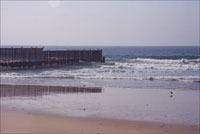
The fence at Border Field State Park.
Photo: Deborah Knight.
Such is the daily — and nightly — cat-and-mouse game that goes on here at Border Field State Park, the southwestern-most point in the continental United States. A grassy picnic area overlooks an empty stretch of U.S. beach, where Pacific breakers roll in and seagulls rest on one leg, biding their time until the tide changes. On one side of the fence sits a giant circular bullring and the fast-growing city of Tijuana. On the other side, like a bulwark against the sprawling city of San Diego, lies a stretch of undeveloped land rare in Southern California. It includes mesas and canyons, a river valley, a coastal estuary, and a national wildlife refuge.
I came to this stretch of land with Greg Abbott, an ecologist with Border Field State Park. Abbott retains the laidback demeanor of the Southern California lifeguard he once was. In the 1970s, he worked on the beach at Border Field, back before the water was found to be polluted by sewage drifting north from Tijuana. He would jog down the beach to help out the Mexican lifeguards with rescues, since they had no equipment — not even fins.
These days, Abbott has turned his attention to trying to save the land. The U.S. Immigration and Naturalization Service, which oversees the Border Patrol, plans to construct a massive border fortification beginning at Border Field State Park and stretching inland for three miles. It will add one or two more fences and a high-speed, all-weather patrol road. Abbott is one of a large number of people who think this is a serious mistake.
New World Border
Border Field State Park was part of a larger tract of land set aside for permanent conservation in 1997, through a deal between the U.S. Fish and Wildlife Service, the state of California, the county, and the city of San Diego. More than 90 percent of California’s coastal wetlands have been lost, making those that survive here particularly ecologically valuable. This area is also home to rare, threatened, and endangered plants and animals, and has been designated a National Estuarine Research Reserve. Millions of dollars have already been poured into protecting and restoring this area, and millions more are in the pipeline.

Greg Abbott.
Photo: Deborah Knight.
In his truck, Abbott took me on a tour to show me why he and many others oppose the construction of the so-called “Triple Border Fence” project here. The existing fence runs from the ocean 14 miles inland. It was constructed in 1992 to stem the nightly tide of immigrants and drug smugglers that swept across the border. This was a popular place to cross: A dash down some scrubby hillsides and through an overgrown marsh offered easy access on the U.S. side to highways and public transportation. By contrast, crossing further inland requires a three-day walk across mountains that freeze in winter and deserts that reach 120 degrees in the summer.
Beginning in 1996, the INS added new equipment and hundreds of new agents here, and the U.S. Army Corps of Engineers came up with its design for the triple border fence. Farther inland, where the land is less hilly, 11 miles of the project have already been completed. The last three miles to the coast, however, resemble a world-class roller coaster of high mesas and steep canyons. Building the project here will require massive — and expensive — earth moving.
Abbott and I stopped first on Lichty Mesa, just inland from Border Field. San Diego’s long dry season was coming to an end, and the plants appeared brittle, gray, and mostly dead. This was an illusion: These plants are natives and know how to bide their time. “This whole hillside will be flowers in the winter,” Abbott said. The mesa is home to somewhere between 50 and 100 species, and because it has never been plowed, it contains a seed bank of now-rare native plants. “It doesn’t look like a jewel, but it is,” Abbott said. The Triple Border Fence project would bury Lichty Mesa.
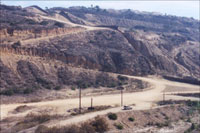
Smuggler’s Gulch.
Photo: Deborah Knight.
We followed the same dirt roads and switchbacks that border agents patrol in their white SUVs: down Yogurt Canyon, up Bunker Hill, down Goat Canyon, up to Spooner’s Mesa. There we stopped and peered down the precipitous 310-foot drop into Smuggler’s Gulch. To build a fairly level, 90 foot-wide, high-speed patrol road that spans the half-mile from this mesa to the next, the Army Corps plans to cut the tops off the two mesas and dump millions of cubic yards of fill into Smuggler’s Gulch.
“To destroy Lichty Mesa is criminal,” Abbott said. “To fill this in is insane.”
Abbott’s boss, Park Superintendent Mike Wells, predicts the massive cut-and-fill work would quickly and uncontrollably erode because bare soils in this region simply wash away in winter rains. Silt would pour into the coastal marsh below, where a multi-million dollar project is underway to remove and prevent silt build-up.
Instead of the Triple Border Fence project, Abbott would like to see improvements to the primary fence and more use of technology, such as the lights, motion detectors, night-vision scopes, and infrared video cameras that are already in place. He calls the triple border fence “the brute force solution.”
Duncan Do-Nots
Opposition to the Triple Border Fence project is close to unanimous. Critics include two federal agencies as well as state, county, and local governments, the area’s two congressional representatives, and numerous environmental, human rights, and archeological organizations. By contrast, the driving force behind the project is one man: Rep. Duncan Hunter (R-Calif.), chair of the powerful House Armed Services Committee, whose district does not even include the 14-mile stretch of border where the project is being built.
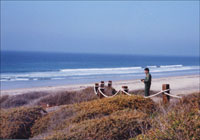
An INS agent patrols at Border Field State Park.
Photo: Deborah Knight.
Critics of the project ask whether spending millions of dollars on one three-mile stretch of fence along a 2,000 mile border is the best use of national-security dollars. Last year, apprehensions here accounted for just 1 percent of the total border apprehensions. It’s true that the crackdown around San Diego has succeeded in dramatically reducing the number of crossings here. However, as migrants simply shifted where they cross, apprehensions elsewhere along the border have shot up — as have the number of migrant deaths.
“All this has achieved is moving the migrant foot traffic into ever more remote and dangerous places,” says Claudia Smith of the California Rural Legal Assistance Foundation. “This is a political strategy of getting the migrants out of the public eye. It has achieved it at an enormous cost of life.” In contrast, she says, there is no political will to crack down on employers that depend on these migrants, even though it is estimated that more than 50 percent of agricultural workers in the U.S. are undocumented. Of those apprehended in the San Diego sector, 99 percent are Mexicans; most of the rest come from Central or South America. “These are economic refugees,” says Cindy Stankowski, director of the San Diego Archeological Center, which opposes the fence project because the entire area is a treasure trove of unexcavated Native American archeological sites, some dating back 9,000 years. “The people coming over are coming across to pick our tomatoes and strawberries.”
Law and Border
The Border Patrol has generally supported the Triple Border Fence project, so I drove the same stretch of border with one of their spokespeople, Raleigh Leonard. Before becoming a supervisor a year and a half ago, Leonard worked for 12 years as an agent. He chose to work the midnight shift, when most of the action takes place. As we drove out to Border Field State Park, we passed the overgrown marsh where dirt roads crisscross each other, and Leonard explained the art of tracking.
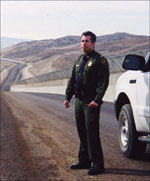
Raleigh Leonard, on patrol.
Photo: Deborah Knight.
“This is the typical Border Patrol agent,” he said, demonstrating the pose as he drove slowly along, his head hanging out the window, watching for tracks. When an agent finds a track, he radios to another, who looks for a similar print on the next road over. If there is none, they do a “pinch,” closing in on the person who is hidden in the vegetation between the roads.
As an agent, Leonard saw himself simply doing his duty: apprehending people and returning them to their country of origin. It wasn’t until he became a supervisor that something else occurred to him: “Man, this is bigger than just jumping over a fence and running for it.” The turning point came one day as he watched a group of young agents who had apprehended six or seven people take down their information.
“I was looking at these people, their faces, and trying to understand what would motivate them to take this risk,” Leonard said. Who were they? What had made them risk the danger of the border crossing and the chance of being robbed, raped, or beaten by those who prey on crossers? Gradually, Leonard came to understand the irresistible draw of a job in the U.S. He realized that, in these people’s shoes, he would probably do the same thing.
Driving up Spooner’s Mesa, Leonard pointed out the Border Patrol’s stadium lights, some on fixed poles, some on mobile trucks. On top of the mesa, he described the seismic detectors that can determine what is passing — a vehicle, an animal, a person. He pointed to a golden eagle perched high atop a pole. Beside the eagle was the Border Patrol’s newest tool: an infrared video camera that surveys the area 24 hours a day. It is remotely controlled and transmits to a monitor at a patrol station. “We’d like more of these, they’ve been so effective for us,” Leonard said.
I asked him what the key was to stopping illegal immigration, and he answered emphatically: more employer sanctions and other kinds of interior enforcement. I asked if this might be a better use of money than the fence. He paused and replied, “No comment.”
Boundary Issues
Four miles inland, we passed the congested San Ysidro port of entry, site of 150,000 daily crossings into the U.S. Beyond the crowds of people, bicycles, and cars, we turned onto a patrol road, so Leonard could show me a stretch of the project that has accomplished its goal. Here, parallel to the primary fence there is a new steel mesh fence, angled at the top; the land has been leveled, and a border-patrol vehicle whizzed past on the new paved road. Leonard gestured toward it and said emphatically, “This area is under control.”
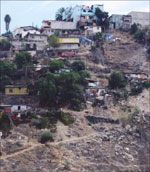
Colonia Libertad.
Photo: Deborah Knight.
Then he pointed across the border and said, “That’s Colonia Libertad, one of the poorest neighborhoods in Tijuana.” Small concrete homes clung to steep, eroded hillsides with no road access, just paths. I guessed there was no electricity, no running water. Leonard said, “There’s your motivation for not staying in your country — right there.”
Those opposed to the completion of the Triple Border Fence project have spent years meeting and corresponding with the Army Corps of Engineers and the Border Patrol. They have repeatedly detailed the problems and suggested alternatives, but to no avail. Hunter remains adamant about seeing the project through to completion. Responding to the environmental concerns, his press secretary said, “You have to balance environmental regulations with protecting your people.”
The day I stood at Border Field State Park with Raleigh Leonard, he pointed out toward the ocean, where a pod of dolphins stippled the water. Among the few other people in the park was a married couple who had come to reminisce: Twenty years ago, as children, both came here frequently to play — he from the U.S. side, she from Mexico. As the area is being restored for wildlife, it’s also being restored for people: a new road to the park, a bike trail to the beach, a place for the area’s burgeoning population to get out and enjoy nature. There is clearly more to guard here than the border.


